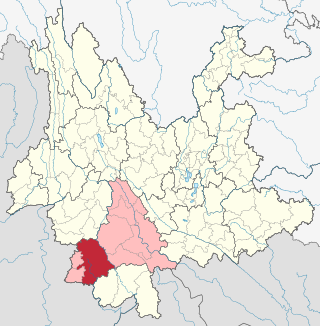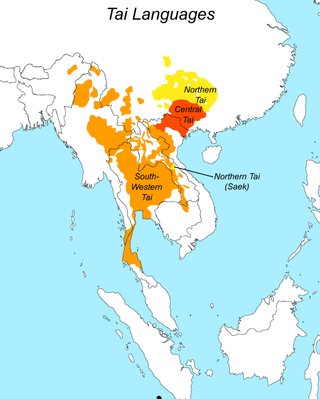Related Research Articles

The Bulang people are an ethnic group. They form one of the 56 ethnic groups officially recognized by the People's Republic of China.

Lancang Lahu Autonomous County is an autonomous county under the jurisdiction of Pu'er City, in southwestern Yunnan province, China. Lancang is the same as Lan Xang, and refers to the Mekong River on its eastern borders and adopted by modern Laos, a Tai word meaning Million Elephants.
Bugan, Bogan, Pakan, or Bugeng is an Austroasiatic language. The existence of the Bugan language was not known by the rest of world until recently. There are about 3000 speakers, mostly in some villages in southern Guangnan (广南) and northern Xichou (西畴), Yunnan Province, China. Bugan is an analytic language, and word order and auxiliary words have important functions in the grammar.
Bit is an Austroasiatic language spoken by around 2,000 people in Phongsaly Province, northern Laos and in Mengla County, Yunnan, China.

Changning County is a county located in Baoshan Prefecture, Yunnan Province, China.

Shidian County is under the administration of the prefecture-level city of Baoshan, in the west of Yunnan province, China. Its seat is the town of Dianyang (甸阳镇).

Shuangjiang Lahu, Va, Blang and Dai Autonomous County is a county in the southwest of Yunnan province, China. It is under the administration of the prefecture-level city of Lincang.

Menghai County is a county under the jurisdiction of Xishuangbanna Dai Autonomous Prefecture, in the far south of Yunnan, China, bordering Burma's Shan State to the southwest. Meng is as variation of Mueang.
Man Met, or Kemie, is a poorly classified Austroasiatic language spoken by about 1,000 people in Jinghong County, Xishuangbanna, China. It is classified as an Angkuic language by Paul Sidwell (2010). It may be or Mangic according to Li Yunbing (2005), or Palaungic. Like most other Austroasiatic languages, Kemie has subject–verb–object (SVO) word order.
The U language or P'uman, is spoken by 40,000 people in the Yunnan Province of China and possibly Myanmar. It is classified as an Austroasiatic language in the Palaungic branch. In China, U speakers are classified as ethnic Bulang.

Tai peoples are the populations who speak the Tai languages. There are a total of about 93 million people of Tai ancestry worldwide, with the largest ethnic groups being Dai, Thais, Isan, Tai Yai (Shan),Tai Lai (Shanni), Lao, Tai Ahom, Tai Meitei and Northern Thai peoples.
Wa (Va) is an Austroasiatic language spoken by the Wa people of Myanmar and China. There are three distinct varieties, sometimes considered separate languages; their names in Ethnologue are Parauk, the majority and standard form; Vo and Awa, though all may be called Wa, Awa, Va, Vo. David Bradley (1994) estimates there are total of 820,000 Wa speakers.
Mảng is an Austroasiatic language of Vietnam, China, and Laos. It is spoken mainly in Lai Châu Province, Vietnam and across the border in Jinping County, China. It was first documented only in 1974.

Palaung or Ta'ang, also known as De'ang, is a Austroasiatic dialect cluster spoken by over half a million people in Burma and neighboring countries. The Palaung people are divided into Palé (Ruching), Rumai, and Shwe, and each of whom have their own language. The Riang languages are reported to be unintelligible or only understood with great difficulty by native speakers of the other Palaung languages.
Va is a pair of Angkuic languages spoken in Mojiang Hani Autonomous County, Yunnan, China. Although the Va autonym is, the language is not Wa, and neither does it belong to the Waic language subgroup. Rather, Va constitutes a separate subdivision within the Angkuic languages.
Lalo is a Loloish language cluster spoken in western Yunnan, China by 300,000 speakers. Speakers are officially part of the Yi nationality, and Chinese linguists refer to it as "Western Yi" due to its distribution in western Yunnan. Lalo speakers are mostly located in southern Dali Prefecture, especially Weishan County, considered the traditional homeland of the Lalo. Historically, this area is the home of the Meng clan, who ruled the Nanzhao Kingdom (737–902 CE). Many speakers of Core Lalo dialects claim to be descendants of the Meng clan.
Pela or Bola, is a Burmish language of Western Yunnan, China. In China, Pela speakers are classified as part of the Jingpo ethnic group. Pela may also be spoken in Burma.
Bisu is a Loloish language of Thailand, with a couple thousand speakers in China. Varieties are Bisu proper (Mbisu) and Laomian (Guba), considered by Pelkey to be distinct languages.
The Hani languages are a group of closely related but distinct languages of the Loloish (Yi) branch of the Tibeto-Burman linguistic group. They are also referred to as the Hanoid languages by Lama (2012) and as the Akoid languages by Bradley (2007).
Laopin is a Loloish language of Menghai County, Yunnan, China. Laopin is spoken in Manpin, Manhong Village (曼洪村委会), Mengzhe Town (勐遮镇), Menghai County.
References
- ↑ Blang at Ethnologue (18th ed., 2015) (subscription required)
Samtao at Ethnologue (18th ed., 2015) (subscription required) - ↑ "Mon-Khmer Classification (Draft)". Archived from the original on 2018-09-22. Retrieved 2012-04-22.
- ↑ Li, Nie & Qiu (1986)
- ↑ "Měnghǎi Xiàn Bùlǎngshān Xiāng Měngáng Cūnwěihuì Xīnmàné Zìráncūn" 勐海县布朗山乡勐昂村委会新曼峨自然村 [Xinman'e Natural Village, Mengang Village Committee, Bulangshan Township, Menghai County]. ynszxc.gov.cn (in Chinese). Archived from the original on 2016-03-05. Retrieved 2013-03-07.
- ↑ "Měnghǎi Xiàn Měngmǎn Zhèn Guānshuāng Cūnwěihuì Guānshuāng" 勐海县勐满镇关双村委会关双 [Guanshuang, Guanshuang Village Committee, Mengman Town, Menghai County]. ynszxc.gov.cn (in Chinese). Archived from the original on 2016-03-05. Retrieved 2013-03-07.
- ↑ Block, Karen Louise. 1994. Discourse Grammar of First Person Narrative in Plang. (MA thesis, University of Texas at Arlington).